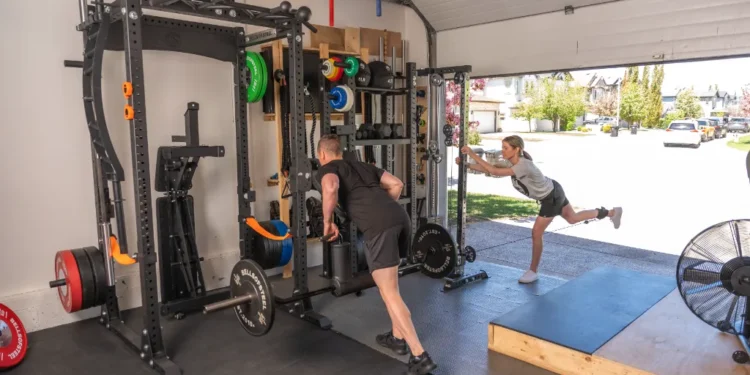Introduction
Building your own home gym isn’t just about convenience—it’s about empowerment. Imagine skipping the commute, the crowded locker rooms, and waiting for machines. A home gym gives you complete control over your fitness environment. Whether you’re a beginner or a seasoned athlete, the right setup can transform how you train.
Table of Contents
Planning Your Home Gym
Assessing Your Fitness Goals
Before buying anything, define your purpose. Are you looking to lose weight, build muscle, or improve endurance? Your goals dictate the equipment you’ll need. For example, muscle gain requires strength tools like barbells and weights, while endurance goals focus on treadmills and bikes.
Budgeting Wisely for Your Setup
Home gyms can cost anywhere from $300 to $10,000+. Start small and expand over time. Prioritize versatile, long-lasting equipment. Think of it as an investment in your long-term health.
Measuring and Optimizing Space
Even a small room can become a functional gym. Measure your area and sketch a layout before buying equipment. Keep at least 3–4 feet of clearance for free movement and safety.
Essential Home Gym Equipment
The Importance of Starting with the Basics
Start with multi-purpose tools that allow for full-body workouts. You can always expand later, but your foundation should cover strength, cardio, and flexibility.
Strength Training Essentials
Barbells and Weight Plates
Barbells are the cornerstone of strength training. Go for an Olympic barbell (45 lbs) and a mix of weight plates. It’s versatile for squats, bench presses, and deadlifts.
Dumbbells: Fixed vs. Adjustable
Fixed dumbbells are durable but take up space. Adjustable ones save room and cost, making them perfect for smaller setups.
Power Rack or Squat Stand
A sturdy power rack allows for safe lifting, pull-ups, and other compound movements. Add a bench, and you can perform hundreds of exercises.
Cardio Equipment Must-Haves
Treadmills
A treadmill is perfect for daily cardio. Look for models with incline control, shock absorption, and heart rate monitors.
Stationary Bikes
These are joint-friendly and ideal for low-impact workouts. If space is tight, consider foldable bikes or spin bikes.
Rowing Machines
Rowers are full-body cardio machines that build both endurance and strength. They’re excellent for compact spaces too.
Additional Functional Equipment
Kettlebells
Kettlebells improve grip strength, coordination, and core stability. A few different weights can cover a wide range of workouts.
Resistance Bands
Cheap, portable, and effective—resistance bands are perfect for stretching, mobility work, and adding resistance to bodyweight exercises.
Medicine Balls and Stability Balls
These help improve balance and are excellent for functional training or ab workouts.
Flooring and Safety Setup
Flooring often gets overlooked, but it’s crucial. Opt for rubber mats or foam tiles to protect your floors and joints. For noise reduction, consider acoustic foam panels or rubberized flooring.
Smart Technology Integration
Fitness tech makes home workouts interactive and engaging. Apps like Peloton, Fitbod, or Apple Fitness+ guide you through routines.
Smart mirrors and AI trainers can analyze your form and offer live feedback—bringing the gym coach right into your living room.
Designing the Perfect Home Gym Layout
Zoning
Separate areas for cardio, strength, and stretching. For instance, keep your treadmill near a window and weights near a wall mirror.
Storage Hacks
Use wall mounts, storage racks, or under-bench drawers to save space. A tidy gym keeps you motivated.
Lighting and Ventilation
Bright, natural light boosts mood and energy. Add a fan or small air purifier for comfort and air circulation.
Setting Up on a Budget
You don’t need to spend a fortune. Start with used equipment or platforms like Facebook Marketplace.
DIY fans can create a squat rack from sturdy wood or fill sandbags for resistance training.
Motivation and Consistency
Create a playlist, add motivational posters, or use a smart fitness tracker to stay accountable.
Consistency matters more than equipment—train regularly, track progress, and reward milestones.
Maintenance and Upkeep
Clean your equipment weekly to prevent rust and bacteria buildup. Lubricate treadmill belts and check for loose bolts or worn cables regularly.
Expanding Your Home Gym Over Time
Once your fitness evolves, invest in premium machines like cable crossovers or advanced rowing machines.
Upgrade based on your needs, not trends.
Common Mistakes to Avoid
- Buying too much too soon
- Ignoring safety setups like mats or racks
- Skipping warm-ups and cool-downs
- Forgetting about proper ventilation and space management
Conclusion
Creating your ultimate home gym isn’t just about filling a room with gear—it’s about building a personal fitness sanctuary. Start simple, grow smart, and focus on consistency. Whether you lift barbells or jog on a treadmill, your fitness journey begins right at home.
FAQs
1. How much space do I need for a home gym?
You can start with as little as 50–100 square feet if you choose compact or multi-purpose equipment.
2. What’s the most essential piece of home gym equipment?
If you had to pick one, adjustable dumbbells offer incredible versatility for most workouts.
3. Can I build a home gym on a budget?
Absolutely. Start with resistance bands, used gear, or DIY solutions to keep costs under control.
4. How do I stay motivated to work out at home?
Set goals, track your progress, and design an inspiring workout space with music and lighting.
5. What are common safety tips for home gyms?
Use proper flooring, ensure equipment stability, and perform regular maintenance checks.


 Home
Home









